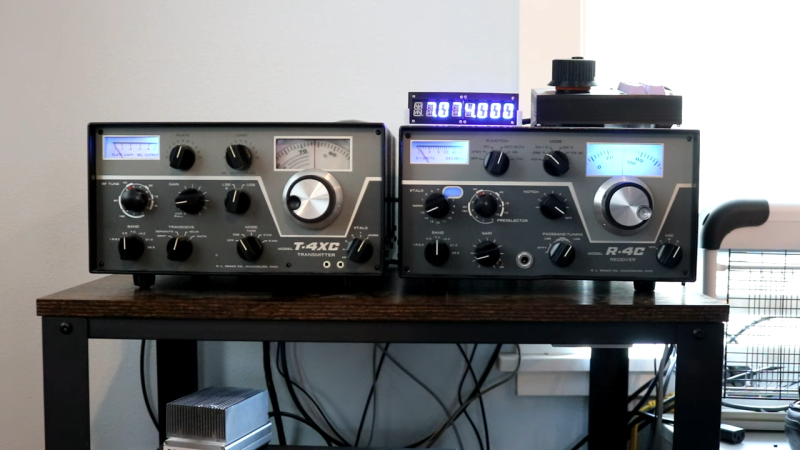In the ham radio trade, gear such as the old Drake units [Dr. Scott M. Baker] has in his radio shack are often referred to as “boat anchors.” It refers to big, heavy radios that were perhaps a bit overengineered compared to the state of the art at the time they were designed, and it’s actually a shame that the name has taken on something of a pejorative connotation, since some of this gear is rock solid half a century or more after it was built.
But older gear is often harder to use, at least compared to the newer radios with microcontrollers and more stable oscillators inside. To make his 1970s-era Drake “Twins” setup of separate but linked receiver and transmitter a little more fun to use, [Scott] came up with this neat Raspberry Pi-based DDS-VFO project to keep his boat anchors afloat. Compared to the original mechanically tuned variable frequency oscillator in the Drake receiver, the direct-digital synthesis method promises more stability, meaning less knob-nudging to stay on frequency.
The hardware used for the DDS-VFO is actually pretty simple — just a Raspberry Pi Zero W driving an AD9850-based signal-generator module. Sending the signal to the Twins was another matter. That was done by tapping into the injection cable linking both units, which meant a few circuit complications to deal with signal attenuation. [Scott] also added amenities like a digital frequency display, optical encoder with crank-style knob to change frequency, and a host of Cherry MX keyswitches for quick access to different features.
From the look of the video below, the Twins are now rock-solid and a lot easier to use. This project is loosely based on a recent panadapter project [Scott] undertook for the receiver side of the Twins.















In the fifties, there was a letter to CQ magazine, asking what to do with a piece of surplus electronics. There was a reply, “tie a chain to it and use as a boatanchor”.
I’ve seen the letter, I’ve seen it attributed to as the origin of “boatanchor”.
Military surplus was heavy, and often you didn’t get much return for that weight. Some of ithad no use for hams.
I can’t remember if the term was used much fifty years ago, but there was lots of ham equipment nobody much wanted, it used tubes, was AM, didn’t offer anything special.
But somehow it became used for any old equipment. That Drake equipment is not overly big, not overly heavy. But somewhere along the way old equipment was seen as valuable, as collectible, rather than something you used because it was cheap and you couldn’t afford better.
Very well done! 😎👍
A DDS seems overkill at first glance, but makes sense for annoying SSB.
Since SSB transceivers (in SSB) usually don’t transmit a carrier wave (not even a lowered one), it’s very tricky to lock onto a common center frequency.
Something like an AFC wouldn’t work, after all.
At least not for SSB. For AM, FM and SSB with a weak carrier it would work.
That’s why the OMs on the bands always discuss how off their voices sound. Too high, too low. ;)
So very accurate oscillators are preferably used, say from an atomic clock or a GPS signal. Or a DDS. :)
many operators prefer not to use dds as it is tends to cause a lot of phase noise in the receiver, that’s why the huff-puff design gets more use.
I’ve seen his interesting projects before. I am glad that he’s getting some attention.
Keeping an anchor afloat? I hope not.
Well, you HAVE to keep it afloat until you want to use it. Otherwise you don’t get anywhere.
Somehow this article triggered an old memory of the ‘huff and puff’ method to add stability to a VFO on those ‘boat anchors’ by locking it to a crystal oscillator. The locking would be turned on when you were not turning the dial and the frequency should remain fixed. A somewhat simple technique that one could put together with a few of the IC’s that were available in the 1970’s. Today you can do almost the entire thing on a pic chip and I think someone sells a board to do this very task. A good reference for this method is this web page: http://www.hanssummers.com/huffpuff/library.html
Here’s the link to the commercially available pic chip circuit I was referring to above: https://shop.elcon.ch/media/docs/el-34_v2.0c_en.pdf I don’t know anything about it other than it’s interesting to look through the pdf about it.
My old ” Elmer” K9FHJ tells the story of his ‘Radio man’ military service during occupation of JAPAN post WWII . As busy work for transmitting stations they would ,on orders , “DEEP SIX”
( ie dunk) whole military transmitters & receivers for 6 mo. In the bay, then pull them up from the buoy & rebuild them to spec. “To Keep Sharp ” . This was known as “working on boat anchors.
I’m sure whoever wrote to GQ magazine had knowledge of this military nomenclature.